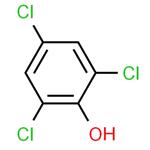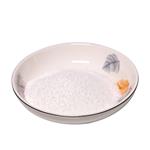- 2,4,6-Trichlorophenol
-

- $42.00 / 1kg
-
2024-02-23
- CAS:88-06-2
- Min. Order: 1kg
- Purity: 0.98
- Supply Ability: 100kg
- 2,4,6-Trichlorophenol
-

- $0.00 / 1kg
-
2023-09-21
- CAS:88-06-2
- Min. Order: 1kg
- Purity: 99%
- Supply Ability: 100tons
- 2,4,6-trichlorophenol
-

- $10.70 / 1Kg/Bag
-
2023-03-06
- CAS:88-06-2
- Min. Order: 10g
- Purity: 99%
- Supply Ability: 10000kg
|
| | 2,4,6-Trichlorophenol Chemical Properties |
| Melting point | 64-66 °C(lit.) | | Boiling point | 246 °C(lit.) | | density | 1.49 | | vapor pressure | 1 mm Hg ( 76.5 °C) | | refractive index | 1.5300 (estimate) | | Fp | 99 °C | | storage temp. | Store below +30°C. | | solubility | 0.8g/l | | form | Crystalline Mass or Crystalline Powder and Chunks | | pka | 6.15 (Leuenberger et al., 1985)
6.10 (Blackman et al., 1955)
6.0 (Eder and Weber, 1980) | | color | white to slightly brown | | Water Solubility | 0.8 g/L | | Merck | 14,9644 | | BRN | 776729 | | Henry's Law Constant | 9.07 at 25 °C (estimated, Leuenberger et al., 1985a) | | CAS DataBase Reference | 88-06-2(CAS DataBase Reference) | | IARC | 2B (Vol. 117) 2019 | | NIST Chemistry Reference | Phenol, 2,4,6-trichloro-(88-06-2) | | EPA Substance Registry System | 2,4,6-Trichlorophenol (88-06-2) |
| | 2,4,6-Trichlorophenol Usage And Synthesis |
| Description | 2,4,6-Trichlorophenol is a colorless to yellow solid that has a strong phenol-like smell. It decomposes at elevated temperatures when heated to produce corrosive and toxic fumes including chlorine and hydrogen chloride. It is soluble in organic solvents and partially soluble in water.
Previously, it was used in the manufacture of other chemicals. Moreover, it was also used as an antiseptic, a pesticide for leather, wood, and preservation of glue as well as an anti-mildew treatment. Nevertheless, the production of 2,4,6-Trichlorophenol was discontinued in America in the 1980s.
| | Health Effects | Human beings may be exposed to 2,4,6-Trichlorophenol via inhalation and can cause altered pulmonary functions, respiratory effects, and pulmonary lesions. Moreover, 2,4,6-trichlorophenol can irritate the lungs and throat causing coughing and wheezing. In animal models, ingestion of 2,4,6-trichlorophenol caused an increase in occurrences of leukemia, lymphoma, and liver cancer. As such, 2,4,6-Trichlorophenol might be a carcinogenic in humans.
Contact can severely burn and irritate the eyes and skin with possible eye damage. Elevated exposures may cause weakness, restlessness, rapid breathing, shaking, tremors, coma, seizures, or even death.
Extreme exposure to 2,4,6-trichlorophenol can have devastating effect on a developing fetus. Other long-term effect to repeated exposure may cause bronchitis with shortness of breath.
| | Chemical Properties | Yellow flakes; strong phenolic odor. Soluble in
acetone, alcohol, and ether; insoluble in water. Nonflammable. | | Physical properties | Colorless needles or yellow solid with a strong, phenolic, musty or rotten vegetable-type odor. At
40 °C, the lowest concentration at which an odor was detected was 380 μg/L. At 25 °C, the lowest
concentration at which a taste was detected was >12 μg/L (Young et al., 1996). | | Uses | Wood preservative; disinfectant; fungicide,
herbicide, defoliant. | | Uses | Fungicide, herbicide, defoliant. | | Uses | 2,4,6-Trichlorophenol is used as a broad range pesticide against insects, fungi, vegetation and bacteria. It has become a common environmental contaminant and probable human carcinogen. | | Definition | ChEBI: A trichlorophenol with phenolic substituents on positions 2, 4 and 6. | | Synthesis Reference(s) | The Journal of Organic Chemistry, 24, p. 1523, 1959 DOI: 10.1021/jo01092a034 | | Air & Water Reactions | Insoluble in water. | | Reactivity Profile | 2,4,6-Trichlorophenol is incompatible with acid chlorides, acid anhydrides and oxidizing agents. 2,4,6-Trichlorophenol can be converted to the sodium salt by reaction with sodium carbonate. Forms ethers, esters and salts by reaction with metals and amines. Undergoes substitution reactions such as nitration, alkylation, acetylation and halogenation. Can be hydrolyzed by reaction with bases at elevated temperatures and pressures. Reacts with alkalis at high temperatures . | | Health Hazard | In experimental animals, 2,4,6-
trichlorophenol causes toxic effects to the liver
and hematologic system and cancer. There is
no reliable information regarding exposure and
toxic effects in humans. | | Fire Hazard | Literature sources indicate that 2,4,6-Trichlorophenol is nonflammable. | | Safety Profile | Confirmed carcinogen
with experimental carcinogenic data. Poison
by intraperitoneal route. Moderately toxic by
ingestion and skin contact. A skin and
severe eye irritant. Experimental
reproductive effects. Mutation data
reported. When heated to decomposition it
emits toxic fumes of Cl-. Used as a
germicide and preservative. See also
CHLOROPHENOLS. | | Carcinogenicity | 2,4,6-Trichlorophenol is reasonably anticipated to be a human carcinogen based on sufficient evidence of carcinogenicity from studies in experimental animals. | | Environmental fate | Biological. In activated sludge, only 0.3% mineralized to carbon dioxide after 5 d (Freitag et al.,
1985). In anaerobic sludge, 2,4,6-trichlorophenol degraded to 4-chlorophenol (Mikesell and Boyd,
1985). When 2,4,6-trichlorophenol was statically incubated in the dark at 25 °C with yeast extract
and settled domestic wastewater inoculum, significant biodegradation with rapid adaptation was
observed. At concentrations of 5 and 10 mg/L, 96 and 97% biodegradation, respectively, were
observed after 7 d (Tabak et al., 1981).
Photolytic. Titanium dioxide suspended in an aqueous solution and irradiated with UV light (λ
= 365 nm) converted 2,4,6-trinitrophenol to carbon dioxide at a significant rate (Matthews, 1986).
A carbon dioxide yield of 65.8% was achieved when 2,4,6-trichlorophenol adsorbed on silica gel
was irradiated with light (λ >290 nm) for 17 h (Freitag et al., 1985).
Chemical/Physical. An aqueous solution containing chloramine reacted with 2,4,6-trichlorophenol
to yield the following intermediate products after 2 h at 25 °C: 2,6-dichloro-1,4-
benzoquinone-4-(N-chloro)imine and 4,6-dichloro-1,2-benzoquinone-2-(N-chloro)imine (Maeda et
al., 1987). | | Purification Methods | Crystallise the phenol from *benzene, EtOH or EtOH/water. [Beilstein 6 IV 1005.] |
| | 2,4,6-Trichlorophenol Preparation Products And Raw materials |
| Raw materials | Hydrochloric acid-->Phenol-->Sulfurous Acid | | Preparation Products | 2,4-Dichlorophenol-->2-(2,4,6-TRICHLORO PHENOXY)CHLOROETHANE-->2-(2,4,6-TRICHLOROPHENOXY)-1-BROMOETHANE-->Prochloraz-->4-Cyanotetrahydropyran-->2,4,6-TRICHLOROPHENOXYACETIC ACID-->2,3,4,6-TETRACHLOROPHENOL-->2,3,6-TRICHLOROPHENOL-->MALONIC ACID BIS(2,4,6-TRICHLOROPHENYL) ESTER-->2,6-DICHLORO-1,4-BENZOQUINONE-->Bis(2,4,6-trichlorophenyl)ethanedioate-->2,6-Dichloroquinone-4-chloroimide-->Pentachlorophenol |
|